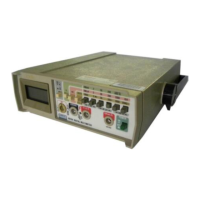3-29. TRUE RMS CONVERTER-
3-30. The True RMS
Converter
in
your
Multimeter
is a
custom
hybrid
circuit that converts the ac
voltage
(from
either
the
voltage
or
current
conditioners)
into a dc
voltage
equal to the true rms
value
of
the
ac signal. This
converter
is
designed
to handle ac signals from 40 Hz to
50
kHz.
3-31, VOLTAGE CONDITIONER
3-32.
The Voltage Conditioner
is
a simple, wide
bandpass circuit. Figure, 3-3 (part A) shows
a
simplified
schematic of
the Input
Signal
Conditioner
for
voltage
measurements. When either the
200
mV or the 2V
range
is
selected,
the input
signal
passes through the top
range
VOLTAGE
CONDITIONER
V/k
WS
RANGE
SWITCHES
200
mV,
2V
INPUT
TERMINALS
COMMON
20V, 200V
1000V
THEORY OF OPERATION
CIRCUIT DESCRIPTIONS
switch, bypassing the voltage
divider
completely.
(The
appropriate
measurement
function of
U3 is enabled
by
the range switches too.)
When
either
the 20V
or 200V
range is
selected,
the
top range switch
is in
the
down
position and the bottom
range switch
is in
the position
shown in Figure
3-3.
The portion
of the
input
signal
between R1 and
R2
is sent
to the A/D
Converter
or the
True RMS Converter. The
voltage divider
ratio is
1:100.
Signals on the 20V range can
now
be measured
by the
200
mV
function of U3.
When
the
lOOOV dc (or
750V ac)
range
is
selected,
both range
switches
(Figure
3-3,
part A)
are in the down position.
This places R3
in parallel
with
R2. The
voltage
divider ratio
is
now
1:1000,
and the input
voltages are measured
by
the
2V function
of U3.
TRUE
RMS
CONVERTER
A/D
CONVERTER
UNKNOWN
INPUT
CURRENT
SHUNTS
(
A. VOLTAGE
MEASUREMENTS
RANGE
SWITCHES
INPUT
TERMINALS
TRUE RMS
CONVERTER
A/D
CONVERTER
UNKNOWN
INPUT
COMMON
B. CURRENT
MEASUREMENTS
UNKNOWN
RESISTANCE
COMMON
;
INPUT
TERMINALS
V/KH/S
'
RANGE
SWITCHES
•
LO
A/D
CONVERTER
UNKNOWN INPUT
VOLTAGE
DIVIDER
•
REF
-
A/D CONVERTER
U
REF
INPUT
•
REF
C. RESISTANCE
AND CONDUCTANCE
MEASUREMENTS
Figure
3-3.
Input Signal
Conditioners
li:
3-5

